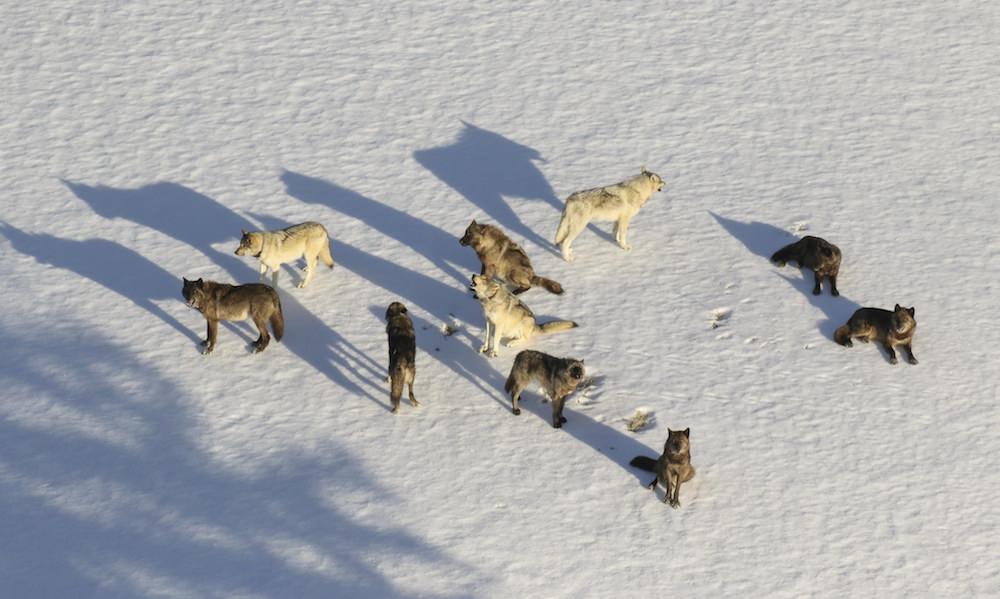Pack Structure
What is a pack?
A pack is considered the fundamental unit of wolf social organization, and it is typically defined as a cohesive family unit that uses an established territory. For the purposes of annual population surveys, the Washington Department of Fish and Wildlife (WDFW) defines a wolf pack as two or more wolves traveling together in the winter.

Pack size and composition
Most packs have between four and ten members, but that number can range from as few as two to as many as 15 wolves per pack. The Druid Peak pack in Yellowstone National Park was exceptional and had 37 members at one point!
Packs can range from small nuclear families, made up of a breeding pair and their offspring, to large extended families with aunts, uncles, grandparents, and stepsiblings. These larger and more complex compositions tend to be more common in landscapes that are saturated with wolves and supported by high prey densities. They also sometimes lead to multiple breeding pairs within a pack.
In a thriving population, wolf pairs produce offspring every spring (following a 63-day gestation period). Wolves often disperse from their natal pack when they are two or three years old and both sexes disperse. Births, dispersals, deaths from disease, fights with neighboring packs, and hunting by humans collectively shape the stability and structure of a wolf pack.
Pack formation
In most wolf populations, a new pack forms when a solitary female pairs with a solitary male. However, in densely populated landscapes, opportunities to find a potential mate in an unoccupied area can be limited. New packs also form through group dispersal or pack splitting.
Group dispersal occurs when two or more wolves permanently leave their former pack together and join unrelated wolves from another pack to establish a new pack territory. In Yellowstone, many new packs formed when either same-sex siblings or same-sex parent-offspring dyads joined unrelated individuals or groups that had dispersed from other packs.
Pack splitting occurs when two or more wolves permanently split off from a pack and establish a new territory together (sometimes adjacent to the territory they just left). This can happen when packs have multiple breeding pairs and resource competition outweighs the benefits of staying together.
Social dynamics within a pack
The prevailing view has long been that wolf packs are socially structured under a strict dominance hierarchy, controlled by an “alpha” male and female pair, with other pack members aligned in a pecking order. This view was primarily based on captive studies, where pack assemblage was largely composed of unrelated individuals interacting under the confines of captivity. It is now well known that captive conditions sometimes produce vastly different behaviors from what occurs in the wild.
“Alpha” status implies intense competition among pack members to improve and/or obtain the highest rank. Leadership positions in most wild wolf packs are determined by parents being dominant over their offspring. However, in places like Yellowstone, relationships that extend beyond parents and offspring also exist, including same-sex second-order relatives such as half-siblings, aunts, uncles, nieces, nephews, grandparents, and grandkids, as well as unrelated individuals. In these cases, it is more accurate to refer to pack members as dominant breeders, subordinate breeders, or subordinate non-breeding males and females.
The dominant breeders typically direct the daily activities of the pack, but every member has a role. Wolves are among the relatively few species where other group members, in addition to the parents, contribute to offspring care. Non-breeding adult helpers are usually, but not invariably, related to pups. This reproductive strategy is known as alloparenting and has been documented in only 2% of mammals, 9% of birds, and <1% of all reptile, amphibian, and invertebrate species combined. Alloparenting duties among wolves are varied and include provisioning pups with food; “pup sitting” at rendezvous sites while other adults are hunting; and teaching pups valuable life skills, such as hunting techniques and how to navigate the landscape safely and efficiently. Alloparenting is an important reproductive strategy among wolves, but it does not occur unconditionally. During times of resource scarcity, helpers may not only withhold provisioning, sometimes they even steal food from pups.
Advantages with pack size
In addition to having more helpers to provision pups, larger packs have a numerical advantage during inter-pack competition for territory. Taking down large prey can sometimes be easier with more individuals, as can defending kills from a guild of scavengers. Studies have shown that ravens alone can remove up to 17lbs of carcass per day and usurp 66% of a lone wolfs’ kill.

Resources
- Cassidy, K.A., MacNulty, D.R., Stahler, D.R., Smith, D.W., and Mech, L.D. 2015. Group Composition Effects on Interpack Aggressive Interactions of Gray Wolves in Yellowstone National Park. Behavioral Ecology 26:1352-1360.
- Harrington, F. H., Mech, L. D., and Fritts, S. H. 1983. Pack Size and Wolf Pup Survival: Their Relationship Under Varying Ecological Conditions. Behavioral Ecology and Sociobiology 13:
- Mech, L.D. and Boitani, L. 2003. Wolf Social Ecology. In Wolves, Behavior, Ecology, and Conservation, edited by L.D. Mech and L. Boitani, pp: 1-34. Chicago: University of Chicago Press.
- Smith, D.W., Stahler, D.R., and MacNulty, D.R. 2020. Yellowstone Wolves: Science and Discovery in the World’s First National Park. Chicago: University of Chicago Press.
- Washington Department of Fish and Wildlife, Confederated Tribes of the Colville Reservation, Spokane Tribe of Indians, USDA-APHIS Wildlife Services, and U.S. Fish and Wildlife Service. 2022. Washington Gray Wolf Conservation and Management 2021 Annual Report. Washington Department of Fish and Wildlife, Ellensburg, WA, USA.
